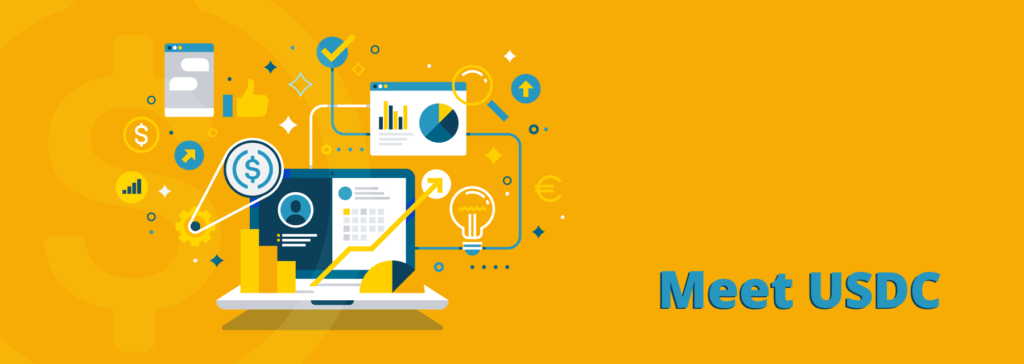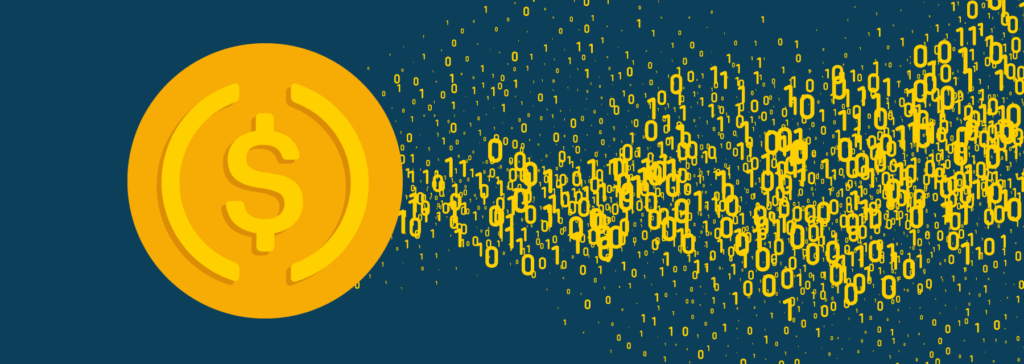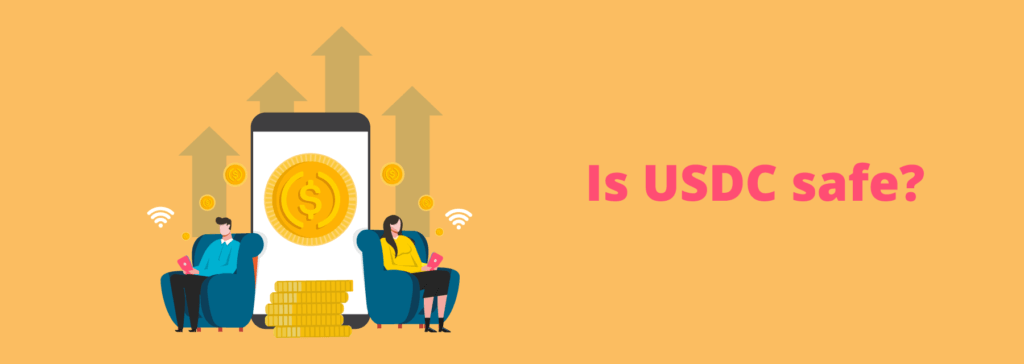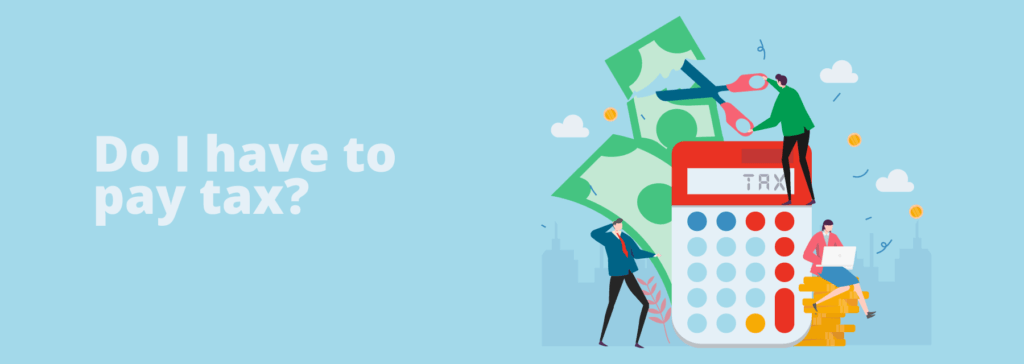
Binance
Only for verified users
Stablecoins are a powerful weapon in a crypto trader’s arsenal.
Let’s meet USD Coin and teach you all about this next generation stablecoin!

Only for verified users


If you’re new to stablecoins, you might be a little confused by them and why there are so many.
But fear not – CryptoMeister is here to explain everything.
Whether you’re a crypto veteran or just starting out, there’s always something that we can teach you.
The decision to buy USD Coin (USDC) is a smart one and there are many reasons as to why you should pick USDC over some of the other stablecoins out there.
Back when USDC was conceptualized, there was a lot of furor around Tether.
Rumors of low liquidity, price manipulation and lies caused widespread panic.
So, to fix that problem once and for all, Coinbase and Circle teamed up to create a new and trustworthy USD stablecoin.
Originally launched on the Ethereum blockchain as an ERC-20 token, it was quickly ported onto other blockchains thanks to its popularity.
Every month, the USDC reserves are audited by top 5 accounting firm Grant Thornton LLP.
These reports are then published on the USDC website for all to see.
This allows everyone to validate and verify that there are more than enough dollars locked away to support the amount of minted USCD.
Very few stablecoins offer this level of transparency, and it’s necessary in a world where companies hide their wrong doings behind smoke and mirrors.
There is no maximum supply cap as more USDC gets minted every time someone buys more.
If someone sells their USDC back to Center, the company that manages USDC, the USDC will be burnt and removed from circulation.

Stablecoins are rather unique in the way that they work.
They run on top of other blockchains as tokens.
More tokens are minted when more people buy them and when people sell them, tokens are burnt.
This keeps the currency pegged 1:1 with the underlying fiat currency.
In the case of USD Coin (USDC), it’s pegged to the value of the US Dollar.
For every 1 USDC in circulation, there’s at least $1 stored away in a secure bank account.
USDC also invests some of these funds into US Treasury Bonds, which allows it to generate income.
It was originally launched on the Ethereum blockchain as an ERC-20 token.
That means that in order to send USDC you’d need a smattering of Ether in your wallet to pay for the gas fees.
You can send USDC to any wallet that supports ERC-20 tokens, and now that USDC is so popular, virtually all crypto wallets accept it.
USDC transactions work just like any Ethereum transaction, settling in a handful of minutes.
When you buy USDC from an exchange, you’ll need to pick the right blockchain to withdraw it to.
Due to the fact that USDC now runs on multiple blockchains, you can opt to withdraw to a different chain.
You can currently use USDC on the following blockchains:
So, if you want to use USDC on the Tron blockchain, for example, you will have to withdraw from the exchange as the Tron variant.
You will be given this option when it comes to withdrawal time.
Picking the right option is critical here as picking the wrong one will result in your USDC being lost forever.
Most exchanges have a failsafe system that will detect that the address isn’t correct if you pick the wrong blockchain.
But try not to rely on this.

Before you buy USD Coin (USDC), it’s a good idea to know what you can and can’t do with it.
While there are some limitations of this stablecoin, there’s still a lot that you can do with it.
USDC’s primary use case is as a stablecoin that you use when trading cryptocurrency.
You will trade your crypto into USDC as a form of hedge against market volatility.
It’s cheaper in terms of trade fees than trading into a non-digital fiat currency.
You can also opt to withdraw your USDC from the exchange and store it safely in a wallet that you control the private keys of.
You cannot do this in the same way with regular fiat currencies.
Many businesses are also starting to accept stablecoins like USDC as a method of payment.
Owing to the fact that the more transparent ones, such as USDC, are pegged at a value of 1:1 with the dollar, more companies have faith in accepting them.
This means that you can actually spend your USDC on goods and services.
Here are just a few applications that currently accept USDC as a payment method:
There are more businesses lining up to accept USDC, so don’t’ be surprised if you find many more.

USD Coin (USDC) does not use its own blockchain network to run.
Instead, USDC runs on top of other blockchains as a token.
For example, on Ethereum it’s an ERC-20 token, on Tron it’s a TRX-20 token and on Algorand it’s an ASA token.
This means that you can swap between chains at the click of a button, swapping your ERC-20 USDC into ASA USDC.
USDC has become incredibly popular thanks to its transparency, and this is the main reason that it’s running on so many blockchains.
The biggest perk of this is that you can then take part in the ecosystem of multiple blockchains at the click of a button.
Whether you want to use your USDC to take part in Ethereum’s decentralized finance (DeFi) world, Tron’s BitTorrent file sharing service or Algorand’s many apps, you’re free to roam.
The possibilities and potential are nearly endless.
It’s worth noting that when you deposit to or withdraw your USDC from an exchange that you pick the correct blockchain.
What we mean by this is that if you’ve got ERC-20 USDC, that you send it to the ERC-20 USDC wallet at the exchange.
The same goes for withdrawing.
Make sure that you pick the correct blockchain for your wallet.
If you want to withdraw to Tron, make sure that you pick the TRX-20 version of USDC.
Most exchanges will have a failsafe that detects if you input the incorrect address.
But try not to rely on this as even that can make mistakes now and then.
Take extra time to make sure you get these small details correct.

When you buy USD Coin (USDC), you’ll want to move it somewhere safe.
You could leave it on an exchange, but it’s not the safest place for it.
So, you’ll need to get your hands on a USDC wallet.
Fortunately, there are dozens of wallets out there that support USDC and its various blockchains.
As we’ve mentioned, USDC runs on multiple blockchains, so the wallet you use will depend on the network that you’re using.
For example, if you’re using the Ethereum version of USDC, you’ll need a wallet that can support the ERC-20 USDC.
As a result, you have a wide range of choices.
The ERC-20 USDC is the most common type of USDC and as a result, there are more of these wallets around.
These are some of the wallets that support the ERC-20 version of USDC:
You can learn more about crypto wallets here.

When you buy USD Coin (USDC), you’re making a transaction that can be tracked on a blockchain.
From the moment you hit buy to the moment you hit sell, your USDC transactions are on the blockchain.
But, how does a USDC transaction actually work?
For the most part, you don’t actually need to know.
The gubbins that goes on behind the scenes is technical sorcery, but it’s fun to see the moving parts from time to time.
So, let’s peek behind that curtain and explain to you how a USDC transaction works!
USDC runs on multiple blockchains, but Ethereum is the most popular, so we’ll make this example using an ERC-20 USDC.
When you head to an exchange to buy USDC, you will be able to buy USDC using a range of cryptocurrencies.
There are often quite a few pairs for USDC, but if there are none with the currency you deposited you will need to swap into a supported cryptocurrency.
Once you’ve managed to buy USDC, you can then head to withdraw.
You will be asked which network you’re withdrawing to.
In this example you need to select Ethereum so that it sends the ERC-20 version.
Then, input the address that you wish to use and the amount.
You’ll need a little bit of Ethereum in your account to be able to cover the gas fees.
Just like any other ERC-20 token transfer you will pay the fees in Ethereum, so bear this in mind.
Once you’re happy with the transaction, hit send.
It will then be sent to the mempool where validators will work to include it in the next block.
Then in 6 confirmations, which is about 3 minutes, the USDC will appear in the recipient’s wallet.
Again, if you wish to then send it on, you will need some ETH in the wallet as well.
ETH is used to pay the gas fees.
Without ETH your USDC will be stuck in that wallet.
You can add ETH at a later date, allowing you to then move your USDC.

USD Coin (USDC) doesn’t run on its own blockchain.
Instead, it runs on top of others as a token.
This means that a USDC address is the same address as the parent blockchain.
If you’re using USDC on Ethereum, you’ll use your Ethereum address to send and receive USDC.
The same goes for Algorand, Solana, and Tron.
Not all wallets support all of the tokens out there, so you will need to double check that your wallet of choice supports USDC before sending it there.
However, USDC is a popular stablecoin, so all good ERC-20 wallets should support it.
There are risks with every cryptocurrency out there, but some have less risks than others.
USD Coin (USDC) is one of the lowest risk cryptocurrencies of all.
This is because USDC is a stablecoin and its price remains stable.
USDC is pegged 1:1 with the dollar, meaning that it doesn’t change in price.
If it does change in price, it’s only a fraction of a cent, which is nothing at all.
USDC is also audited every month to ensure that reserves are correctly kept and maintained.
So, where does the risk with USDC come in?
Well, there are 2 risks that you need to be careful of when using USDC.
The first is making sure that you use the right network.
When you withdraw USDC from an exchange, you can pick the network you wish to use it on.
If you fill in the incorrect details, you’ll lose your USDC forever.
There’s no getting it back.
So, take extra time and care when sending USDC so that you keep it on the correct network.
The second risk is theft.
All technology can be hacked, so if you’re not careful and don’t follow basic cyber security techniques, you could have your USDC stolen.
If you want to mitigate this, we’ll go into more detail on the subject, so feel free to skip ahead.

Many cryptocurrencies play a game with the law, balancing on the fine edge between legal and illegal.
So, before you buy USD Coin (USDC), it’s a good idea to learn whether it’s legal or not.
After all, you don’t want to throw away money, do you?
USDC is from a company called Center.
Center is a joint operation between Circle and Coinbase.
Both Circle and Coinbase are regulated and licensed to operate in the USA.
As a result, Center and USDC both follow all the regulations and rules.
To make sure that USDC doesn’t fall foul of any fallout from the Tether trouble, USDC gets audited monthly.
This ensures that the correct amount of cash is held in reserve in relation to the current issuance.
In a nutshell, USDC is perfectly legal and does not come close to breaking any laws or rules.
You might not be able to use USDC at too many businesses around the world, but this is because stablecoins are not yet authorized as a payment method alongside traditional fiat currencies.
However, we are getting there, and we should see this be the norm in the next 5 years or so.

If you’re wondering whether it’s safe to buy USD Coin (USDC) or not, then you’re in the right place.
We’ve done our homework and looked around to see if it’s safe to buy USDC or not.
Due to the fact that USDC’s parent companies, Circle and Coinbase, are fully regulated, they only sell USDC to the most reputable exchanges.
This means that only the best and safest exchanges can offer USDC pairs.
As a result, you’re safer when you buy USDC as the exchange has already gone through a vetting process.
You should still be wary about leaving funds on an exchange for long periods of time.
Even if the exchange is reliable and trustworthy, they can still get hacked.
USDC will be stored in the hot wallets, and those are the first to get drained during a hack.
So, protect you and your new USDC by moving it to a wallet that you control as soon as you can.

The number one fear of everyone that will buy USD Coin (USDC) is getting hacked.
Getting hacked and having your USDC stolen is a terrifying thought, but it happens far too often.
Your USDC is only as safe as your weakest cyber security point.
Now, there are 2 types of hacks or attacks that you could face.
There are hacks of opportunity and targeted hacks.
Everyone has the skills to protect themselves from hacks of opportunity, so we will start there.
First up, make sure that you’re using a unique password for every single website, app, exchange and wallet that you own.
No 2 passwords should ever be the same, so use an app like LastPass or 1 Password to help you with this.
Aim for 12 characters or more to be on the safe side.
Next, you want to enable 2-factor authentication (2FA) on all your accounts.
Using a dedicated 2FA app like Google Authenticator or Authy is more secure than using SMS or email 2FA as both of those can get hacked easily.
Then, when you create a wallet, you’ll want to write down your seed phrase on a bit of paper.
From there, you can transfer it to whatever you want, just keep it away from the internet.
Some people have hidden their seed phrases inside video games, inside the freezer, under the bed and even in the ground.
You can pick anywhere you want, just make sure that you won’t forget where it is.
If someone gets hold of your seed phrase, they can load your wallet onto their device, taking control of your USDC.
Finally, try not to brag about how much crypto you own when you’re online, especially if your username links back to you.
This will make you less of a target and keep you off the radar of hackers.
If you follow all of these steps, you’ll make yourself hard enough to hack that most people won’t want to even bother.
But you’re still vulnerable to more advanced hackers.
If someone wants to specifically hack you and steal your crypto, there are many ways it can be done.
But, unless you’ve got hundreds of thousands of dollars’ worth of crypto, you don’t need to worry about this.
Let’s just say that all the hacking and devices used in Mr Robot are actually legitimate.

Now you’re all set and armed with knowledge about USD Coin (USDC), you’re ready to buy USDC!
If you’re worried, don’t be – it’s easy and simple to buy USDC.
The only way to buy USDC is through a cryptocurrency exchange, so you’ll need to sign up and make an account with an exchange.
There are many exchanges that support USDC, so you’re spoilt for choice in that department.
If you’re wondering if you can trade USDC with leverage, then you’re out of luck.
USDC is a stablecoin designed to remain at a constant price.
This means that trading USDC with leverage would be a pointless exercise.
You’d have to pay to open the trade, you’d then pay interest every 4 hours on the position, and then you’d pay to close the trade.
As profitable as it would be for exchanges to offer this market, none currently do.
You will have to stick to buying USDC using a spot market instead.
If you want to know which exchanges you can use to buy USDC, we’ve got you covered.
You can buy USDC at the following exchanges:
Once you’ve created your account, or logged in to your exchange account, you’ll need to fund it.
You can use any of the supported payment methods at each particular exchange.
Then, head to the crypto markets section and search up USDC.
Once you’ve found USDC, you’ll be able to input the amount you wish to buy and complete the order.
It takes less than 2 minutes to buy USDC if you’ve already got an account set up at an exchange.

Once you’ve found the exchange you want to buy USD Coin from, it’s time to decide how you want to pay.
Most exchanges have the same payment methods, but a few will have a couple more that you don’t see everywhere.
For example, Binance will let you use PayPal, while Kraken will let you deposit cash if you head to a Canada Post office in Canada.
For the exchange you’re using, you can check out their accepted payment methods in our detailed reviews.
The most common and popular payment method to buy USD Coin (USDC) is credit or debit card.
These types of deposits are instant, but they usually come with a fee.
The fee ranges from 1% all the way to 5% at some exchanges.
It’s worth bearing in mind that card issuers will often place daily limits on card purchases, so don’t use your card for large deposits if you can avoid it.
This will prevent you from going over the daily limit on your card and it will save you a fortune in fees.
If you get charged a 5% deposit fee on a €1,000 deposit, that’s a lot of lost money.
Some banks will block deposits to exchanges using your card, so you will need to use an alternative payment processor that doesn’t mark it as a crypto deposit.
Most exchanges will have an option available for these eventualities.
If you’re going to make a big deposit in order to buy USDC, then you should opt for a bank transfer.
These are totally free to make and have an unlimited deposit cap.
The only drawback of a bank transfer to buy USDC is the fact that it can take up to 3 working days to process the deposit.
This is a bit frustrating, but it’s worth it for larger amounts owing to the money you’ll save on fees.
If your bank isn’t happy with you making a deposit at a crypto exchange via bank transfer, you might need to look at workarounds.
As deposits need to come from an account in your name, you can always look at other options such as PayPal or virtual banks.
A couple of crypto exchanges will allow you to deposit using PayPal.
To do this, you simply log in to your PayPal account on the deposit screen.
It’s the same process as checking out with PayPal at any other merchant.
Once you achieve this you can then fund your account and buy USDC.
Using PayPal is a great way to get around banking bans on crypto as your bank sees it as a PayPal deposit rather than a transaction to a crypto exchange.

The likelihood of making money from holding USD Coin (USDC) is very slim.
It’s a stablecoin pegged at a value of 1:1 with the US Dollar.
As a result, it barely moves, and when it does move, it’s less than a cent.
As a result, it’s hard to make profit from it, let alone make enough profit to hit a taxable level.
But, You could buy USDC when it’s around $0.99 and sell if it goes to $1.01, which does happen from time to time.
If you did this with a good deal of volume, you could end up making a tiny profit.
Throw this in with profits from other crypto trades and it could potentially impact the tax payable at the end of the year.
Generally speaking, tax on crypto profits is paid at the same rate as capital gains tax.
The upshot of this is that if you make a loss, you can deduct it from your tax bill.
Some countries have crypto tax laws in place, allowing you to reduce your tax bill significantly.
Australia, Germany and Malta will all reduce your tax bill up to 100% if you hold crypto for more than a year.
On the other hand, if tax doesn’t exist where you live, then you can get away without paying any tax, which is the dream.
You can learn more about crypto tax here.

If you’re looking to buy USD Coin (USDC) as an investment, then it’s probably a bad idea.
USDC is more of a hedge currency designed to keep your portfolio safe during times of high volatility.
USDC is pegged 1:1 to the US Dollar, meaning that it doesn’t increase or decrease in price.
This results in no profit to be made from investing in USDC.
Instead, you can use USDC as a stablecoin to protect you from adverse market movements while paying less fees than converting to a pure fiat currency.
There are many stablecoins around, but few are as transparent and regulated as USD Coin (USDC).
So, if you’re going to buy USDC, it’ll give you peace of mind knowing that it already has a massive leg up on the competition.
USDC is currently ranked 8th by market cap, making it the second most popular stablecoin around.
Only Tether ranks higher, but Tether is a ball of mess and looks set to implode.
Binance has its own stablecoin, known as BUSD, but it doesn’t have any markets outside of Binance.
So, as it stands, USDC has the greatest dominance and market share out of the legitimate and safe stablecoins.
This command should stand the test of time and we’ll likely see it replace Tether as the top dog once that cesspit finally kicks the bucket.

USD Coin (USDC) doesn’t really follow any of the supply and demand trends that you get with other currencies.
It has a floating market cap which adjusts as people buy USDC or sell USDC.
What this means is that when someone goes to buy USDC, Center will mint enough to cover the request.
When someone goes to sell USCD, Center will burn the USDC and reduce the supply.
This is constant and is not reflected in the price.
There’s no limit on the amount of USDC that can be printed, so long as there’s enough USD in Center’s bank account to cover it.
As a result, USDC doesn’t adhere to supply and demand principles.
The cryptocurrency space is growing at a frightening rate, and this means that all cryptocurrencies will face growing pains.
USD Coin (USDC) is no exception to the rule, and it too will eventually face some issues later in life.
So, let’s look to the future and see what challenges USDC could face!
As it stands, USDC complies with all the regulations and laws that are present in the USA.
This is because Center, the company behind USDC, is run by Circle and Coinbase.
These 2 companies comply with all regulations in the USA and abroad.
As a result, we should see USDC remain compliant with anything the global regulatory bodies throw at it.
But, that’s not to say that Coinbase could opt to pull out of a particular market due to regulatory requirements.
If this happens, we could see USDC pulled from those markets too.
On the auditing front, USDC is ahead of the game and already employs the best techniques and practices.
As it stands, USDC is already the 2nd biggest stablecoin.
Only Tether stands in its way of the number 1 spot, and it won’t be long before Tether crashes and burns.
In terms of market cap, only Binance’s stablecoin, BUSD, is close.
If the market remains this way, USDC will have free roam and will be declared the premier USD stablecoin in the crypto space.
We could see Gemini’s stablecoin, GUSD, catch up eventually, but that’s a big if.
Gemini focuses heavily on regulatory compliance, which means that it’s slow moving.
If it can speed up its movements, then it could compete with USDC.

USD Coin (USDC) is the standout USD stablecoin.
It solves all of the issues that Tether has created, and it’s already fully regulated.
USDC is live on multiple blockchain networks, giving you true versatility.
There’s not much that can be said as a negative of USDC, other than the fact that on Ethereum it gets a bit expensive to use.
If you’re looking for a high-quality USD stablecoin that isn’t going to let you down or get involved in a major scandal, then USDC should be your first choice.
USD Coin is currently supported by a number of top blockchains.You can use USD Coin on the following blockchain networks: